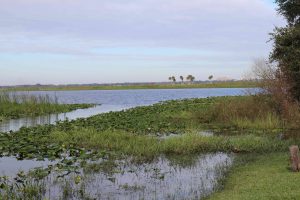Close your eyes for a moment and imagine you are on the shoreline of a pristine lake. What comes to mind? Perhaps you envision birds wading in the shallows, fish darting through the water, and colorful lotus flowers floating on the surface. What do you imagine for the water itself? If you are like most people, you are probably imagining that the water is clear and blue. The “perfect” image of healthy water.
People often think of water clarity as an indicator of water quality – in other words, how “healthy” the lake is. But what do scientists mean when they say “water clarity”? How is water clarity linked with aquatic plants? Is clear water actually better? Let’s explore these issues.
What is water clarity?
Water clarity is a measure of how deep in the water light can penetrate. This is important for submersed aquatic plants and algae, which need light for photosynthesis. Both dissolved substances and suspended particles are important aspects of water clarity.
Dissolved substances affect the color of the water, often turning it reddish or brown, and can come from plants or inorganic sources like iron. Take brewing a cup of tea for example – a dissolved substance called tannin leaches out of the tea leaves, turning the water brown. Dissolved substances result in the “dark water” lakes that you can find throughout Florida.
Suspended particles, on the other hand, include any algae that are floating in the water as well as any sand or sediment that gets stirred up from the bottom of the lake. These particles absorb and scatter sunlight, reducing the clarity of the lake. In most lakes, the most important type of suspended particles affecting water clarity is algae.
What are the links between aquatic plants and water clarity?
Simply put, water clarity affects plants and plants affect water clarity. Water clarity is very important for submersed plants – plants need sunlight to survive and water clarity determines how deep within the water submersed plants can grow. However, aquatic plants themselves also influence the water clarity of a lake.
For example, submersed plants compete with algae for nutrients, reducing the amount of algae within the water. In addition, plants that are rooted into the bottom of the lake keep nutrient-rich sediment from getting stirred up into the water. This reduces the amount of suspended sediment particles in the water and also keeps nutrients away from free-floating algae.
According to Florida LAKEWATCH, a volunteer water-quality monitoring program, lakes that have plants covering 50% or more of the bottom area have less algae and clearer water. If plants cover less than 30% of the bottom area, the plants have little effect on the water clarity of the lake. This is important to keep in mind when you think about aquatic plant management. For lakes with less than 30% plant cover, aquatic plant management is unlikely to affect water clarity. However, if submersed plant cover is reduced from levels that are greater than 50% to those that are less than 30%, water clarity is likely to be reduced.
Is clear water “better”?
Given these issues, is clear water “better”? Not necessarily! While clear water is often more aesthetically pleasing, it does not always indicate that the lake is healthy. Clear water can still harbor pathogens, pollutants, and contaminants while dark or murky water may be perfectly safe for swimming and recreation. Many lakes in Florida are naturally dark or eutrophic (nutrient-rich) due to dissolved substances and our unique geology.
This blog post was written by Dr. Candice Prince, Assistant Professor with UF/IFAS. CAIP. Questions or comments can be sent to the UF/IFAS CAIP communications manager at caip@ifas.ufl.edu.
Follow UF/IFAS CAIP on social media at @ufifascaip. Read more blogs like this one on the UF/IFAS CAIP blog.
UF/IFAS Center for Aquatic and Invasive Plants. Turning Science Into Solutions.
 0
0

